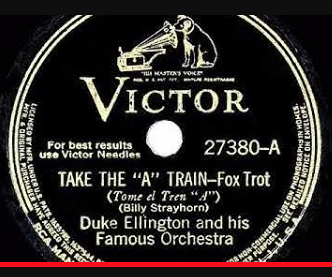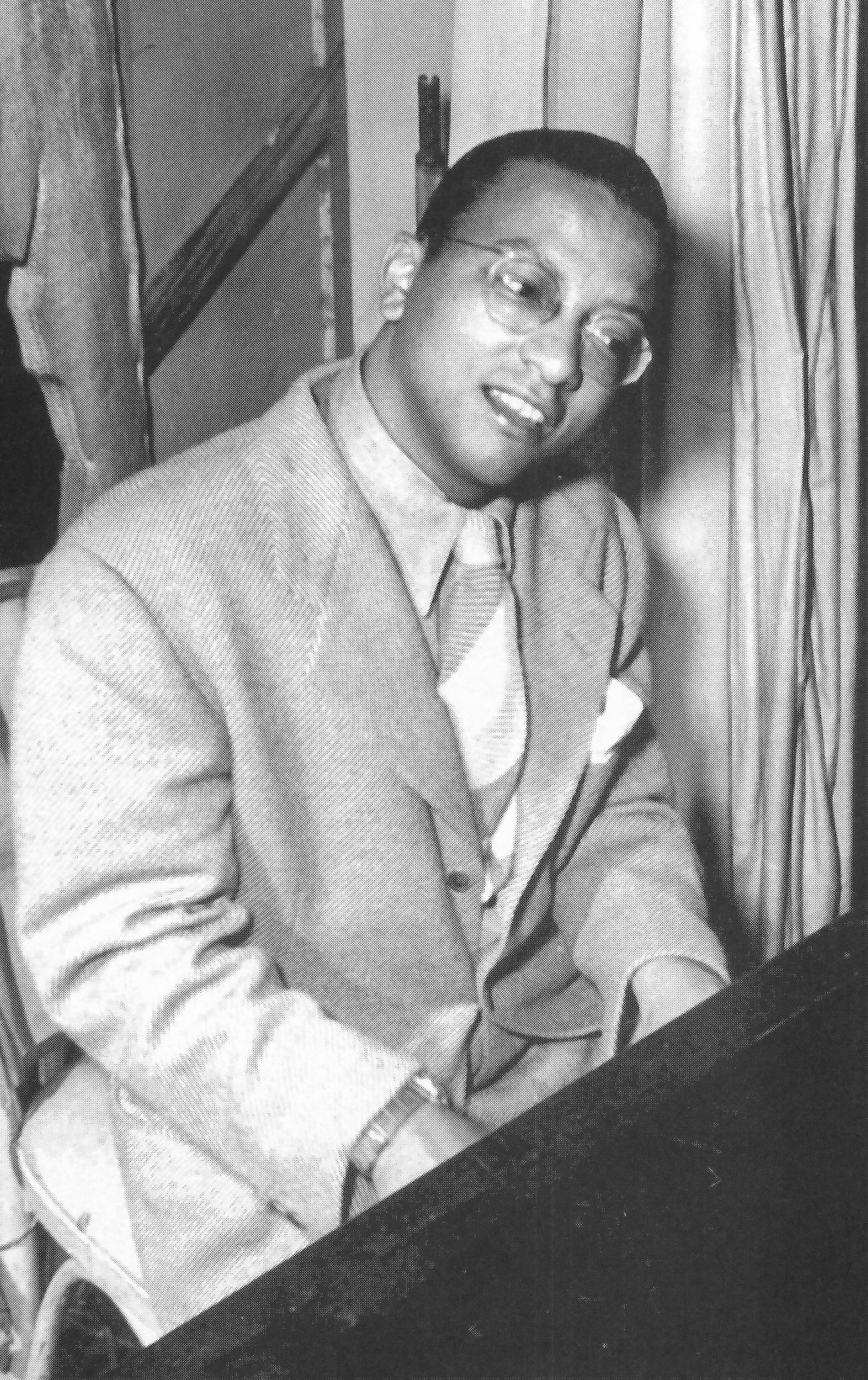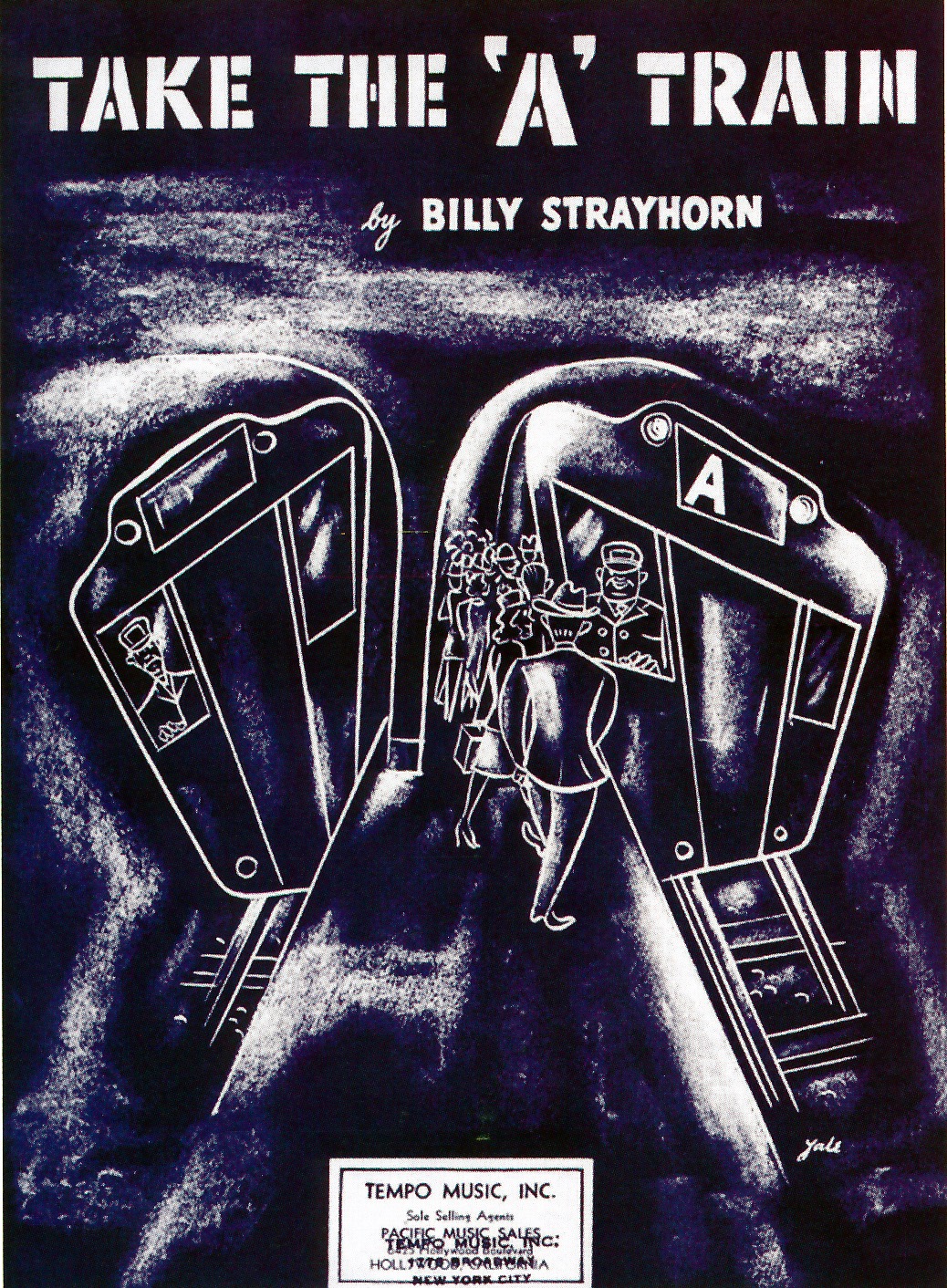

This composition nearly didn’t get recorded. “Take the A Train,” which became a big hit, the theme tune for the Duke Ellington Orchestra and ultimately a jazz standard, remained in manuscript form and almost forgotten for two years after Billy Strayhorn composed it. Strayhorn had given Ellington the score almost immediately after it had been composed. But Ellington, despite hiring Strayhorn, did nothing with it. Not until two years later in January 1941, when a crisis in the musical world created a desperate need for new compositions, did Strayhorn resuscitate the “Take the A Train.”
The story of those two years revolves around the development of the musical relationship between Duke Ellington and Billy Strayhorn. It started in December 1938 when Ellington visited Strayhorn’s home town, Pittsburgh, for a gig at the Stanley Theatre. A close friend of Strayhorn, who had connections through his uncle, managed to initiate a meeting in Ellington’s dressing room. The 23-year-old Strayhorn played the piano for the bandleader and impressed him to the extent that he invited Harry Carney and Johnny Hodges to listen in.
Ellington wanted to hire the young musician but had no position for him. So he got him to write some lyrics overnight and then invited him to New York in the new year. Never having been to New York, Strayhorn requested information on how to get to Harlem. This was when Ellington told Strayhorn to “take the A train.”

About a month later, Strayhorn was taken to New York by a friend, Bill Esch. Anxious to impress Ellington, he took with him a new composition based on the directions he had been given to get to Harlem: “Take the A Train.” Strayhorn later claimed that the score was “born without any effort—it was like writing a letter to a friend.” (Hajdu, Lush Life, 55-6) One of his friends, Mickey Scrima recalled that Strayhorn was worried it sounded too much like a Fletcher Henderson arrangement and not enough like Ellington.
Ellington was finally tracked down at the Adams Theater and given the score. There is no information about Ellington’s reaction, but Ellington set him up in the Harlem YMCA and put him in contact with his son Mercer, who was studying at Juilliard. For the next two years “Take the A Train” seems to have been forgotten as Strayhorn befriended Mercer, moved into the Ellington family home and became increasingly involved in working for Ellington.
The event that brought back “Take the A Train” was a dispute between ASCAP and BMI which led to a ban on ASCAP recordings on radio. Since the whole Ellington repertoire was ASCAP, this ban meant that the orchestra could not broadcast at all and would lose a major source of income. Ellington urgently needed new material under BMI and set Mercer and Strayhorn to compose a whole new repertoire. According to Mercer Ellington, “Overnight, literally, we got the chance to write a whole new book for the band.” (Hajdu, 83-4) Among the number of new compositions to emerge was “Take the A Train.” Strayhorn had probably kept a copy and introduced it to Mercer. There is an apocryphal story that Mercer found the original score all screwed up in the garbage.
“Take the A Train” was the first of the new compositions recorded on February 15, 1941. There has been some discussion that Ellington had a hand in streamlining the score—and indeed Duke originally had his name listed as co-composer. But Strayhorn asserted, “the little version that was on Victor 78, that was exactly how I wrote it. It just happened to come out to three minutes.” (Down Beat, 30 May 1956)

The Music
00:00-00:05 Piano intro
00:06-00:28 Melody played twice by saxes with muted trumpets behind
00:29-00:39 Bridge played by saxes with trombones behind
00:40-00:50 Melody by saxes with brass behind
00:51-01:36 First trumpet solo (muted) with saxes behind
01:37-01:43 Short transition by ensemble
01:44-02:14 Trumpet solo (open) with ensemble
02:15-02:18 Descending motif
02:18-02:50 Melody repeated three times by saxes, each quieter than last
02:51-02:55 Final chord
This composition, basically a “riff” (Barry Ulanov, Duke Ellington, 225), was not typical of Strayhorn’s compositions, nor was it typical of Ellington’s. (Perhaps this is why Ellington put the score aside after Strayhorn had handed it over in 1939.) The composition is in the standard 32-bar format and uses the Fletcher Henderson technique of employing the three orchestra sections (saxes, trumpets and trombones) as units to work in the call-response style or to add riffs to support the melody or the soloist. In 1966, Strayhorn told Stanley Dance of his admiration of Henderson: “One day I was thinking about his style, the way he wrote for trumpets, trombones and saxophones, and I thought I would try something like that.” (Down Beat)
Walter van de Leur stresses how the composition uses Swing conventions: “Its string of choruses, ample solo space against a background riffs, and unison saxophone lines with snappy brass answers.” (Something to Live For, 49) Unlike many of the contemporary arrangers, Strayhorn didn’t always use rich harmonies for his three units; indeed, the saxes play the melody in unison. The initial playing of the melody—“its unforgettable theme” according to Schuller (136)—is supported by contrapuntal riffs by the muted trumpet and trombone sections. This opening section is almost instantly memorable and “so clear and uncluttered” (Schuller 136). At 00:51 the first solo begins. This is played by Ray Nance on muted trumpet with brightness and restraint. This brilliant solo is enhanced considerably by the harmonized sax section’s accompaniment. Following this, there is a short ensemble interlude where modulation leads to increased emotion for the bridge. Here Nance’s now open trumpet and the sax section interact in a call-response routine, with the trombones eventually joining in. The number reaches a climax 02:15 with a striking bell-like descending motif. The recording ends with the melody played three times in diminishing volume to suggest the A train disappearing into the distance. Schuller calls this ending an “In the Mood-like fadeaway coda.” (Schuller, 137)
There is so much music condensed into this 02:55 recording. First, there are many subtle allusions to the underground train. Second, the riffs contain many variations, rhythmic and harmonic. Such variations are not usual in this type of jazz composition. Third, there are seamless transitions throughout. Fourth, the inspired band plays this difficult score faultlessly. As Schuller has written: “…the piece, in itself so clear and uncluttered, elicited quite naturally the kind of superior performance it got—and deserved.” (Schuller, 136) Fifth, Ellington’s four-bar intro, which has become famous too, is worth careful attention.
The Muted Trumpet Solo
Nance’s solo has been universally praised. Indeed many subsequent jazz musicians soloing on “Take A Train” have paid homage to the solo by quoting it either partially or fully. Duke Ellington himself has called Nance’s solo “one of the great trumpet solos of all time.” (Carter Harman Interview Collection, Smithsonian, 1964) And two members of his band, Lawrence Brown and Harry Carney, who both participated in the original February 15 recording, have also commented positively on Nance’s solo.
Today there is complete agreement that it was Nance who soloed on this seminal recording. However, at the time of the recording, according to A. H. Lawrence, several writers assumed the muted…solo was played by Rex Stewart.” (Duke Ellington and His World, 301) As I discovered during my research for this article, one of those writers was Gunther Schuller, who wrote in his seminal The Swing Era, “The second chorus [of the recording] is devoted entirely to Rex Stewart, who, very tightly muted, delivers one of the most cohesive solos of his career.” (136) This was published in 1989 by a revered Ellington specialist who once said that he must have listened to “Take the A Train” more than a thousand times.
His belief that Rex Stewart played this famous solo deserves some consideration. Significantly, Rex Stewart was initially designated to play the solo in the score. Duke himself has described what happened: “Rex Stewart got temperamental or something. He was originally supposed to play the solo. Then it was given to Ray Nance, and he blew this chorus which was one of the great choruses of all time.” (Carter Harman Interview #5 Smithsonian, 1964) It’s likely then that some writers assumed it was Stewart soloing because his name was on the score.
I have listened to Stewart for many years, especially the four wonderful tracks from Paris in 1939. And listening to this first solo on “Take the A Train,” I can see why some writers might think the soloist was Stewart. For example, there is a very Stewart-like moment in the solo where the trumpet drops a whole octave (01:25)—a technique used a great deal by Ruby Braff. As well, a comparison with Stewart’s “Montmartre” solo about three years earlier provides some similarities. But there is not enough to convince that the solo is Stewart’s.
Nevertheless, I went back to all the Ellington recordings from 1939 to 1941 and listened to all the solos by Stewart and Nance. Their soloing is quite different and easily identifiable: Nance essentially goes for a pure trumpet sound, whereas Stewart, who also plays cornet, has a distinctive sound that uses the valves and his lip to get a variety of sounds.
Part of the problem is that the “Take the A Train” solo is played on muted trumpet. The mute eliminates a lot of the individual aspects of a soloist. And I conclude that he use of the mute was crucial in Schuller’s error in naming Stewart as the soloist.
The Legacy
There have been countless recordings of “Take the A Train” over the years. The best ones are noted in Ted Gioia’s The Jazz Standards. My favorite version is by Maynard Ferguson’s British Orchestra from the 1960s. It was broadcast on BBC radio. I was lucky enough to have recorded the program on reel-to-reel tape by holding the tape’s microphone up to the radio speaker. Despite this primitive recording method, the music shines through. Alas, it has not issued been on record.
Waiting for the A train. Tony Alers Hankey fourth from left.
The Lyrics
These are the lyrics used by Ella Fitzgerald for her 1957 recording Ella Fitzgerald sings the Duke Ellington Songbook.
You must take the A train
To go to Sugar Hill way up in Harlem
If you miss the A train
You’ll find you missed the quickest way to Harlem
Hurry, get on, now it’s coming
Listen to those rails a-thrumming
All aboard, get on the A train
Soon you will be on Sugar Hill in Harlem
Footnote
There is perhaps one more source on the Nance/Stewart issue. In 1993 the Smithsonian published a score of “Take the A Train” that was transcribed from the original 1941 recording. I have not been able to obtain it. But would really like to since the score was issued with an essay by Gunther Schuller on the composition. It would be interesting to see whether he addressed the Nance/Stewart issue.
This article is dedicated to the memory of Tony Alers-Hankey, who at 82 flew from the UK to New York to attend a jazz recording. He also took the opportunity to take the A train. (photo above)
4 Comments